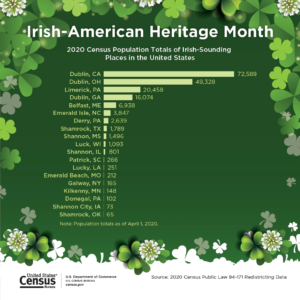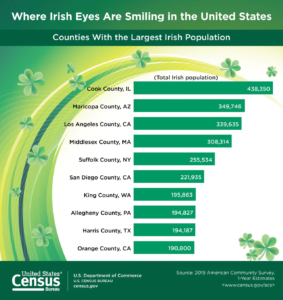

- This event has passed.
Irish American Heritage Month
March 1, 2023 - March 31, 2023
March is Irish American Heritage Month! The earliest recorded celebration of Irish Americans in the United States dates back to 1762 with the first St. Patrick’s Day parade in New York City. The parade became an annual event, with President Truman attending in 1948. Irish heritage is strong in America: More than 31.5 million residents claim Irish ancestry, second only to German (43.0 million). When it comes to U.S. presidents, including current President Joe Biden, exactly half (23) trace some of their roots to Ireland.
In October 1990, Congress passed a public law establishing March 1991 as Irish-American Heritage Month. In 1991, President George H. W. Bush issued the first proclamation designating March as Irish American Heritage Month. Each year since the president has made a proclamation regarding Irish American Heritage Month. In 2022, President Biden made a proclamation on March 3rd where he stated, “The story of Irish Americans has always been one of strength and perseverance through adversity. Many Irish immigrants arrived on America’s shores to escape the Great Famine, only to face discrimination, prejudice, and poverty. Despite these hard times, they embraced their new homes in every corner of America—from the Atlantic to the Pacific, across the Midwest and through the Rocky Mountains—and helped build and fortify our Nation into what it is today.” He went on to discuss the ties that Ireland and the United States have to one another and encouraged all Americans to honor the journey and perseverance of the Irish immigrants who have helped shape America. Read President Biden’s full proclamation here. On February 28, 2023, President Biden’s proclamation included an acknowledgment of his great-grandparents’ hopes and dreams upon arriving in this country and the “grit” they showed. He stated, “Ireland and the United States are forever bound together by our people and our passion. Everything between runs deep.”
People from Ireland started immigrating to America while it was still a colony of Great Britain. The first Irish arrivals in the 1600s were mainly indentured servants or redemptioners, whose passage was paid in return for a certain number of years of work. By the 1700s, Protestants, Catholics, and Quakers were coming to the United States to start new lives without religious discrimination and the draconian laws against the Celtic heritage of the Irish.
While many of the Irish immigrants in the early 1800s were skilled workers, by the middle of the century, most were simply fleeing the famine and poverty of their homeland. Not enough land and the Great Famine of the 1840s resulted in millions coming to the United States in search of a better life. Instead of finding farms in their new country where they had lived in their former homeland, many settled in big cities, including Boston, New York, and Philadelphia. These unskilled workers were part of the foundational workforce for increasing industry and manufacturing in the United States. They also helped build roads and canals throughout the country, such as the Erie Canal in New York.
As conditions in Ireland improved, the new immigrants tended to be more skilled, and the schools, charitable societies, workers’ organizations, and social clubs established by earlier Irish immigrants smoothed their entry into American society. While some discrimination against these immigrants lingered, having the support systems in place allowed the new families to prosper and succeed more quickly in their new homes.
Along with contributing their backbreaking work in building much of the country’s infrastructure and manufacturing plants in the 1800s, Irish immigrants brought their strong social structures with them to support each other and the Americans around them. America continued to be the country of choice for many young Irish people wanting to improve their lot throughout the 20th century.
Did you know that Irish immigrants were involved in the Mexican-American War of the late 1840s? They switched sides during the war as Irish immigrants faced discrimination for their Catholic faith in a mainly Protestant country. Many chose to support Mexicans who were from a predominantly Catholic country during this war. Those Irish immigrants were among the captured and died by hanging. Although Mexico lost this war, the Irish who fought along with them are perceived as heroes of the St. Patrick’s Battalion (El Batallón de San Patricio). If you’re interested in reading more about this piece of Irish immigrant history, click here.
Another part of Irish immigrant history involves how this immigrant group moved up the socioeconomic ladder after experiencing hardship and discrimination in their homeland and in America. Irish immigrants competed with Black Americans for low-paying jobs, often refusing to work alongside Blacks, and at times terrorizing them. Eventually, Irish Americans gained privileges that other whites had. Learn more about this experience here.
Today, it is estimated that 38% of Black Americans have Irish heritage, including Barack Obama, Beyoncé, and Colin Powell. There are organizations recognizing the shared culture and heritage, such as the African-American Irish Diaspora Network to strengthen identity and connection.
March 17th is St. Patrick’s Day. Although this holiday originated as a religious holiday, St. Patrick’s Day has evolved into a celebration of all things Irish.
Resources/Events
- County Ventura St. Patricks Day Parade | (venturastpatricksdayparade.com)
- Smithsonian- Irish American History and Heritage
- The United States Census Bureau
- A Grand Celebration of Irish American History and Culture
- During the Mexican-American War, Irish-Americans Fought for Mexico in the ‘Saint Patrick’s Battalion’ | History| Smithsonian Magazine
- How Irish Immigrants Overcame Discrimination in America (thoughtco.com)
- African American Irish Diaspora Network (aaidnet.org)
 Kids and Families Together
Kids and Families Together

